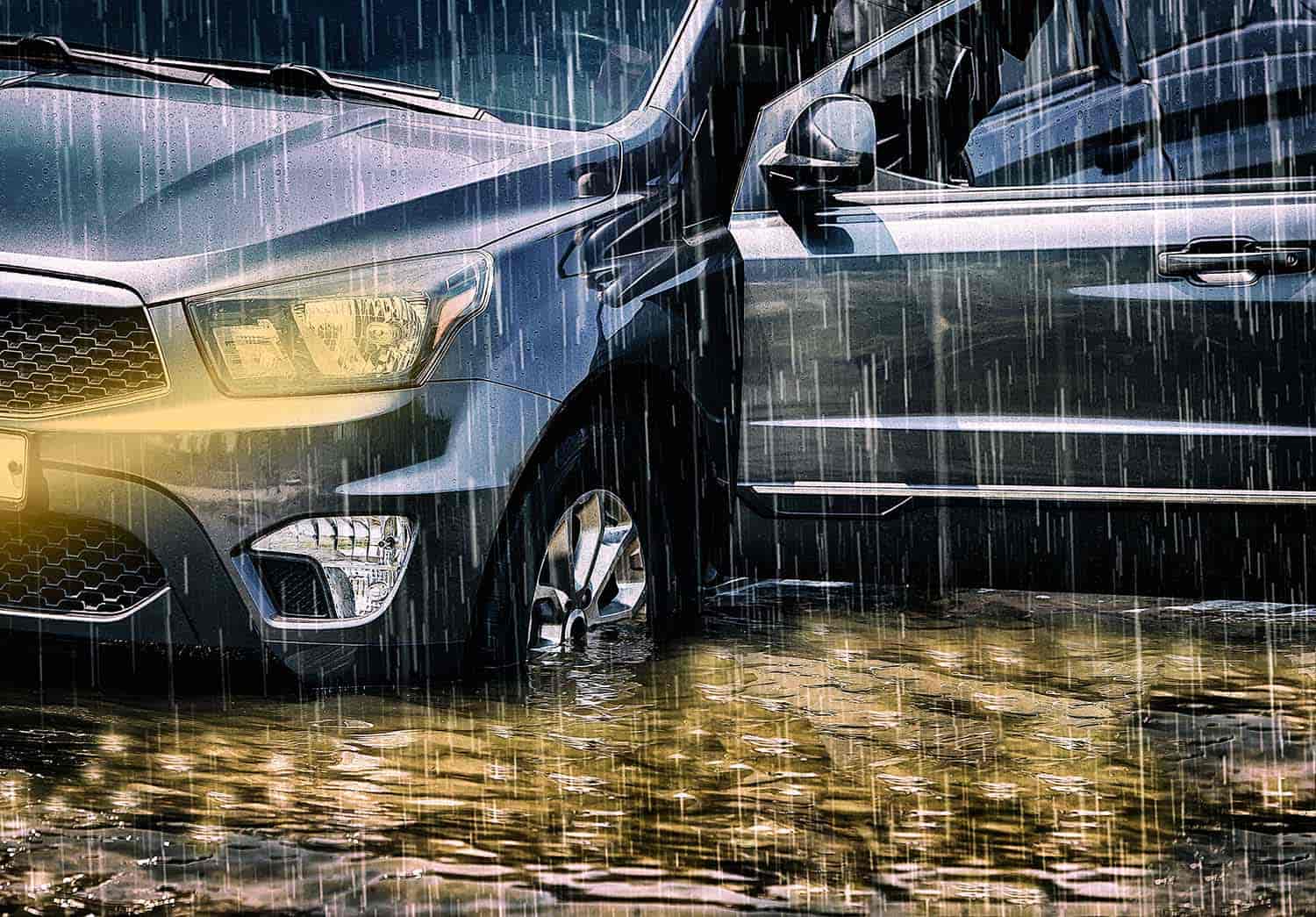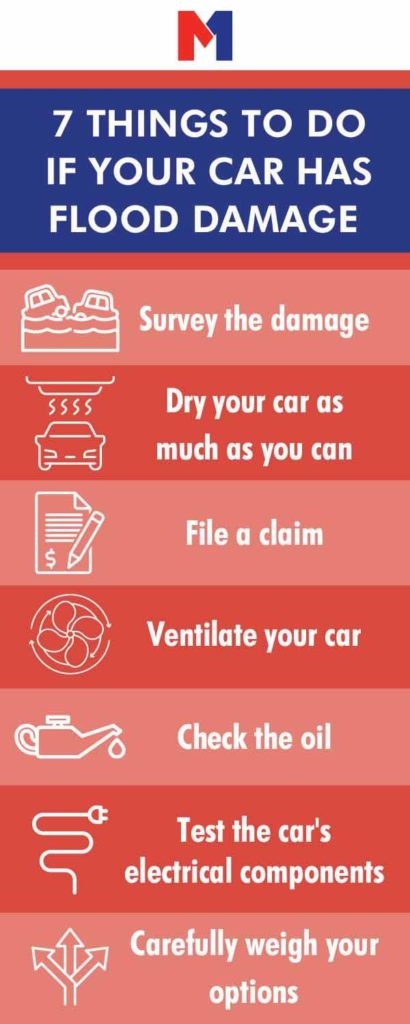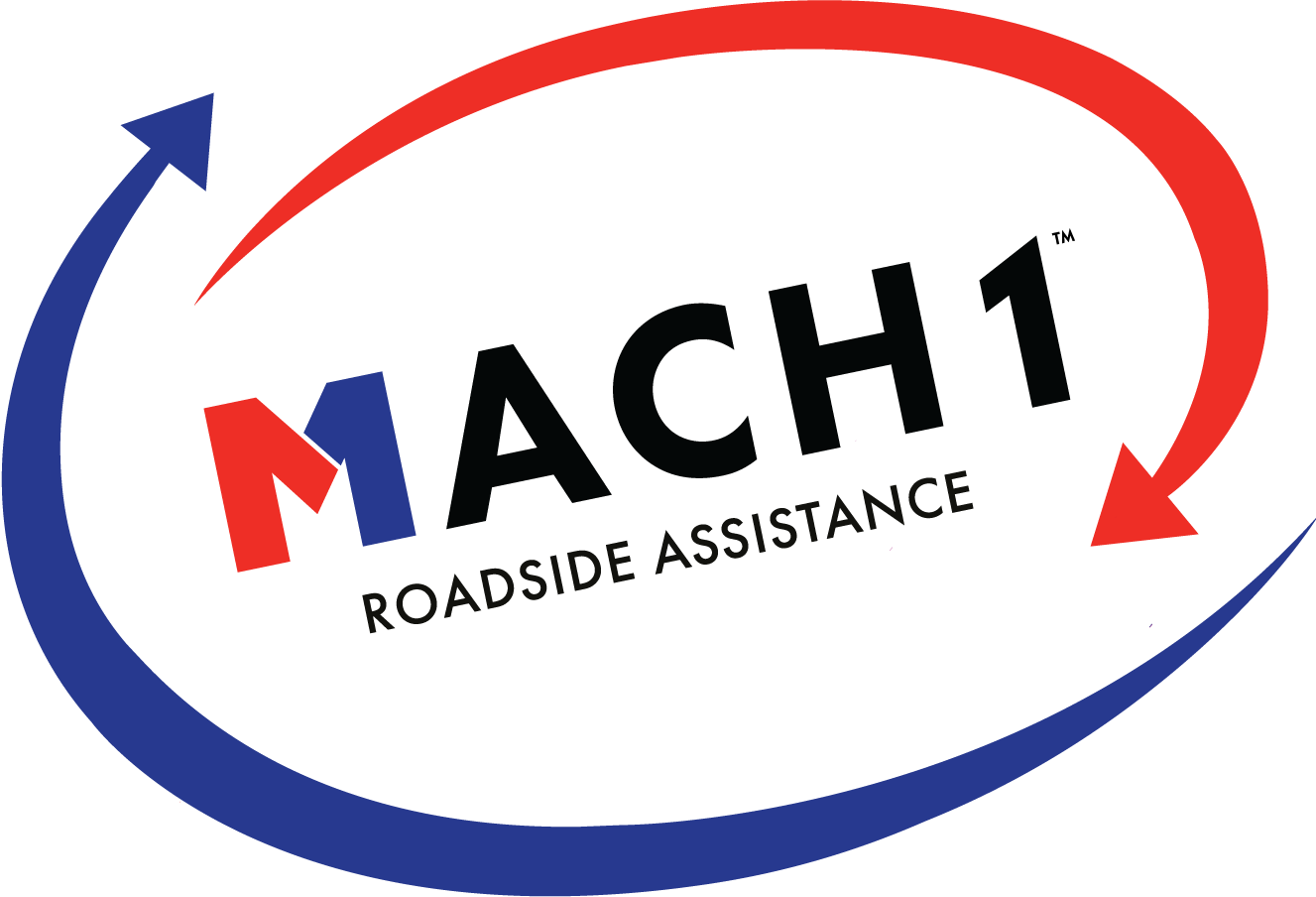
19 Jul 7 things to do if your car has flood damage
Mother Nature sometimes decides to surprise us with all types of weather conditions. Floods destroy many electrical things, and if they aren’t destroyed, they will have some damage to them. Once a car is flooded, many aspects of it change completely.
Floods can damage the car’s electronics, lubricants, mechanical systems, and safety features such as airbags. If you ever feel like your car could have suffered flood damage, the best you can do is take the car to a mechanic, give them your suspicions and let them check it for any damages. Some damages are repairable if the water wasn’t much, but unfortunately, sometimes the car would be wrecked.
Flood damage to your car doesn’t mean that it won’t work. It will still run after a few repairs, but the car will stop working in the long run if it sat in water for too long or if your mechanic is not experienced enough with flooded cars. If water gets in your car past the dashboard, significant parts in the vehicle will keep deteriorating in the engine and other internal car parts with time due to water damage.
While it seems unavoidable to have flood damage on your car, there are precautions you could take to make sure your car doesn’t suffer in times of flooding.
Can a car still work after being flooded?
The first thing you should avoid doing when you find your car in a flood is turn on the engine. When you turn on an engine with water, the cylinder block and piston will endure excessive damage leaving you with a totaled car.
The amount of water damage your car experiences will determine whether it’s still repairable or not. If you drove your car through a pond on your way to work, the damage wouldn’t be much, the most that could be damaged is the brake linings, and you can change those.
On the other hand, if your car has submerged in water past the floorboards into the electrical areas, your insurance company will most probably declare it a total loss. Don’t get me wrong; there is still a possibility to dry it out and change the fluids in the car. But your car will still have electrical problems, musty odors, and silt in the seats. All this can be repairable or not, depending on your car model and how old it is. Older cars won’t survive such a hit.
Cars that are completely submerged in water during flooding can be more expensive to repair than buying a new car. To prevent going down this rabbit hole, let the mechanic observe the vehicle and tell you how much damage the car has endured. That’s when you can decide whether to repair or count your losses and buy a new car. But with proper insurance coverage, you might be compensated.
7 Things To Do If Your Car Has Flood Damage
 If you just found your car sitting in a pool of water, you would be scared and not know what to do. Here are a few things you can do to try and redeem your car before the damage is too extensive.
If you just found your car sitting in a pool of water, you would be scared and not know what to do. Here are a few things you can do to try and redeem your car before the damage is too extensive.
Survey the damage
When you find your car submerged in a flood, please look at how much damage it could have endured. When doing your checks, also take pictures for your insurance just in case you’re going to need them.
Would you mind not starting your car when it’s in this condition? Starting it without knowing whether there is water in the engine or not could be detrimental to your engine. When you start an engine with water, it could result in a hydrolock where the piston fails to compress as it should. Hydrolocks could result in an enormous repair bill or buying a new car.
Dry your car as much as you can
When your car is flooded, the first thing you should do is to make sure you get as much moisture out of the car as possible. If you don’t dry out your vehicle, mold will grow, and it will always have a musty odor. If your car is still in a flooded area, get it to higher grounds using a towing service, then dry it out.
Drying your car as quickly as possible could save you more damage than necessary. You can use a wet or dry vacuum to suck out all the standing water. Using a regular vacuum could result in electric shock. Be sure to get as much water out as possible.
To dry your seats and cushions, you could use a dry towel.
File a claim
If you have comprehensive auto insurance, your insurance company will pay for repairs or pay you the car’s value if it’s totaled. Most of the other insurance policies only cover damages that aren’t too extensive and don’t involve flood damage.
With a comprehensive insurance policy, you can call your agent and let them know about the condition of your car so you can decide how to proceed. Remember that your comprehensive policy covers most repairs from floor mats to the engine at the repair shop.
If your policy covers theft and fire, it most likely covers floods too. Thoroughly go through your insurance policy to be sure about what it covers and what it does not.
Ventilate your car
If it’s a bright sunny day, you’ll be lucky. Open up all your car doors after drying and cleaning up the car. A good flow of air in your vehicle will help get rid of the foul odors, dry out the car, and prevent mold and mildew. If the weather isn’t that good, you can use fans to dry out the car’s interiors.
If your seats are removable, take them out to dry in the sun. There are items in your car that might need changing, including carpets, mats, upholstery, and door panels. Having mold and foul odor in your vehicle can cause a drop in its value, and it will be challenging to sell it later on.
Check the oil
Water getting into your car’s oil could result in many engine problems. The presence of water droplets on the dipstick means you could have a potential problem. This is why you never start your car after it’s water damaged. You can change the oil in your vehicle or call a mechanic to do it for you. The tank will have to be emptied to get all the water out.
Test the car’s electrical components
Water and electronics are big enemies. You need to know if any parts of your car have suffered from water damage before presenting a problem later on. Check your car’s wiring before you even decide to turn on your vehicle. If the wiring is OK, you can now start checking other aspects of the car’s electronics to make sure they’re all good.
You can check the headlights, turn signals, power locks, tail lights, power windows, and other components that are connected to the car’s wiring. Also, check the brakes, clutch, power steering, coolant reservoirs, and steering for damage.
Carefully weigh your options.
If you’ve had your car evaluated, check to see if the repair cost is higher or equal to the price of a new car. If repairing the vehicle is more expensive, you should start browsing for another vehicle. When looking to buy a used car, make sure you have the car’s history, its repairs, ownership, title branding, among other things. Make sure a mechanic you trust inspects the vehicle to make sure everything is fine. Do this before you commit any amount of money.
Can you save a flooded car?
It depends on the type of water that flooded the car. If you’re living in a coastal area, your car might have been flooded with salty water. If that’s the case, don’t even try to save it. That car is toast. Saltwater does damage to vehicles beyond repair.
If it’s fresh water, then your car can be repaired by an experienced mechanic. It would help if you didn’t let a mechanic who hasn’t dealt with flooded cars repair your car. Without experience in repairing flooded cars, there is no point for a mechanic to repair yours because they will make it worse, and you’ll end up losing a lot of money plus the car itself.
Electrical issues in a flooded car are what could cost you a lot of money. To be sure your car is totally fine, those must be fixed. If water got into your fuse box, control units, or modules, they would need replacing. The problem with such items is how expensive they are after significant hurricanes. You must replace them because if you don’t, they will cause problems down the line. They might operate for a while then fail eventually.
You will also need to replace the battery cable and wiring harness as they are critical areas too.
The issue with a flooded car is what comes with the water rather than the water itself. Mud and silt are a bit difficult to get out of your vehicle, and these always result in significant issues. When you miss spots where mud or silt has settled, it will be hard to control the damage that comes with it, like mold and mildew.
How much does it cost to fix a flooded engine?
It is simple and incredibly cheap to repair the car interiors and upholstery after it has been flooded. But when it comes to the engine, the issue gets a bit too complicated. Fixing other interiors that don’t involve the machine could cost you at most $20 because you can do most of the work by yourself, such as drying the interiors. But when your car is hydro-locked, the issue gets a bit costly.
A flooded engine might cost you anywhere between $3000 and $8000 to fix. The process of repairing that engine is complicated, too, and you might have to stay without your car for quite a while.
The price stated for fixing a flooded engine cannot be a sure estimate since not every mechanic will fix it with the same price. Before you consider repairing your car’s engine, first have it evaluated, know whether it will be worth repairing, getting a new engine, or just buying a new car altogether.
Final Words
Floods are damaging to any electrical devices, and cars are among those. When your vehicle has endured a flood, you should act fast and make sure your car doesn’t sit in the water for too long. The longer your car sits in the water, the more damage it will suffer, which isn’t good.
The best you can do is get as much water out of the car as humanly possible and rush it to your mechanic. Your mechanic will most likely help you determine how much damage the vehicle has endured and what step you should take next.
